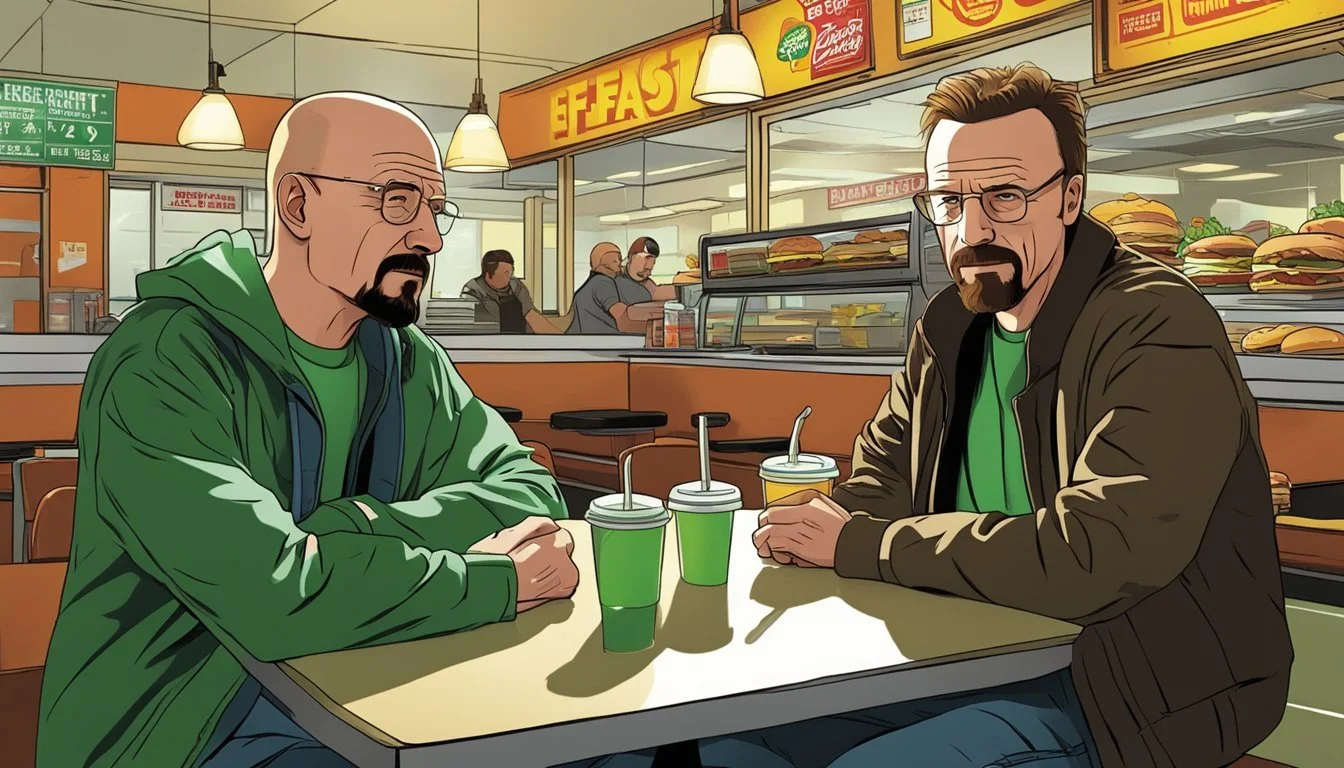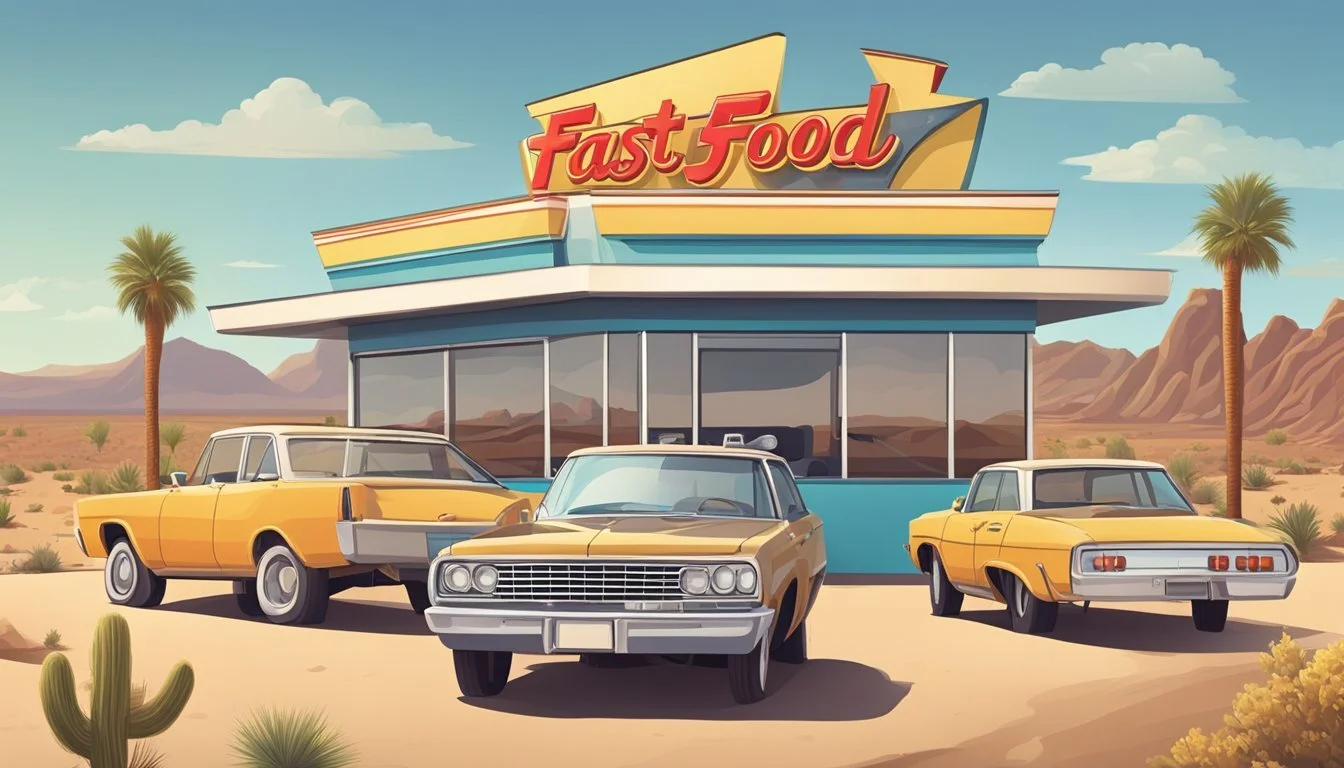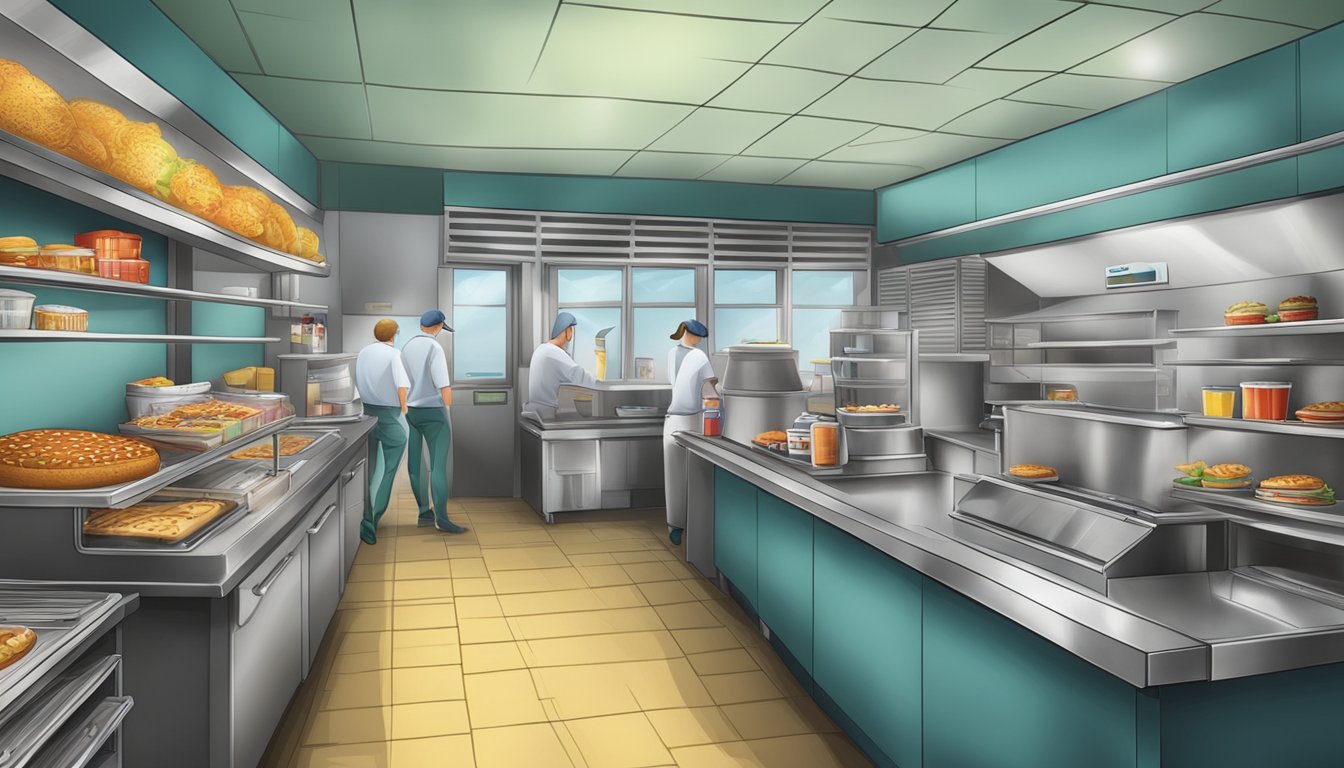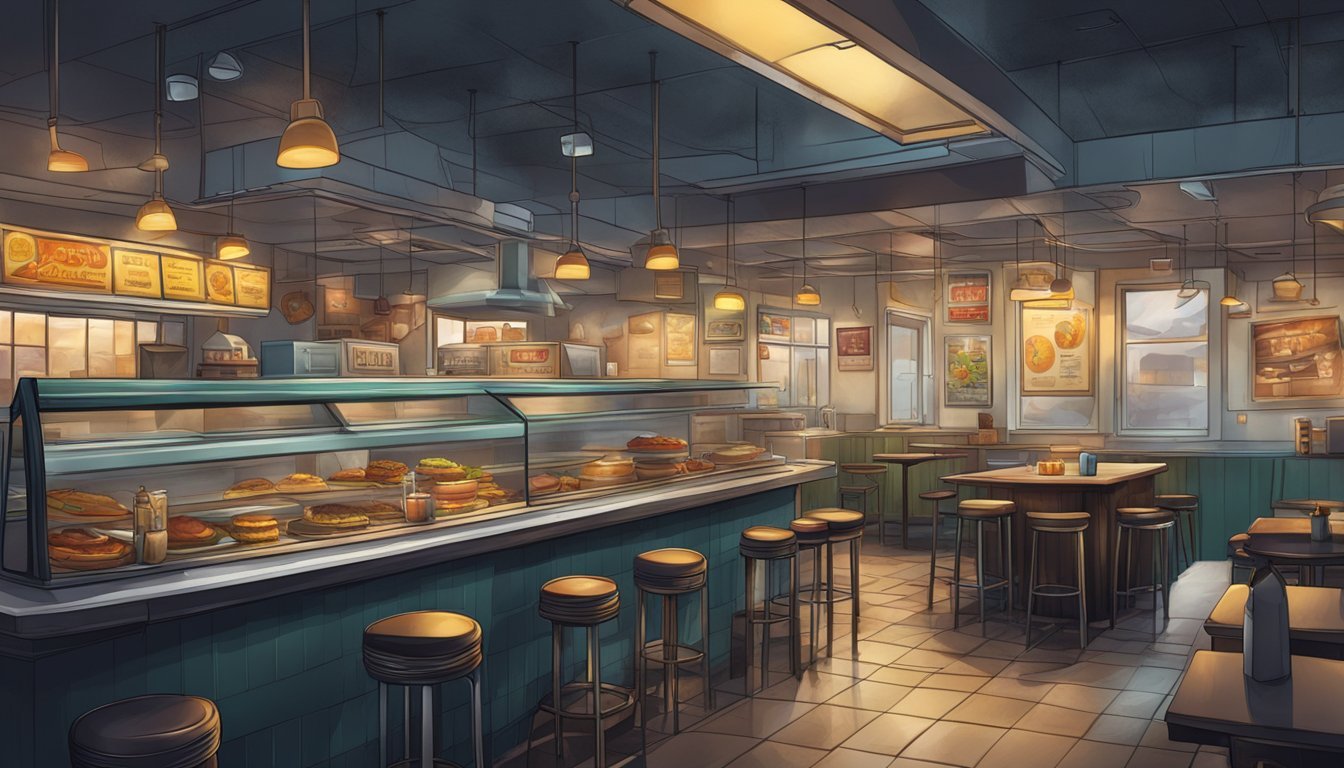The Role of Fast Food in Breaking Bad's Narrative
A Culinary Lens on Crime Drama
Breaking Bad's intricate narrative weaves together various elements to create a compelling story, with fast food playing a surprisingly significant role. The series, created by Vince Gilligan, uses everyday settings to juxtapose the criminal underworld with ordinary life. Fast food establishments serve as more than mere backdrops, becoming integral to character development and plot progression.
Los Pollos Hermanos, the fictional fast-food chain owned by drug kingpin Gus Fring, exemplifies how seemingly innocuous businesses can mask sinister operations in Breaking Bad's world. This restaurant becomes a central location for pivotal scenes, showcasing the duality of Fring's character and the thin line between legitimate enterprise and criminal activity. The contrast between the bright, clean fast-food environment and the dark undercurrents of the drug trade adds depth to the show's exploration of moral ambiguity.
The use of fast food in Breaking Bad's narrative structure extends beyond Los Pollos Hermanos. Other establishments serve as meeting points for characters, providing neutral ground for tense encounters and negotiations. These familiar settings create a sense of normalcy that sharply contrasts with the high-stakes criminal activities unfolding within them, enhancing the show's unique blend of everyday life and extraordinary circumstances.
Breaking Bad's Phenomenon
Breaking Bad emerged as a cultural juggernaut, captivating audiences worldwide with its gripping narrative and complex characters. The show's rise to prominence can be attributed to its creator's vision and the lasting impact it made on popular culture.
Vince Gilligan's Vision
Vince Gilligan crafted Breaking Bad with meticulous attention to detail and character development. His unique approach to storytelling transformed a high school chemistry teacher into a drug kingpin, exploring themes of morality and consequences.
Gilligan's emphasis on visual storytelling and symbolism elevated the series beyond typical crime dramas. The show's iconic moments, like Walter White's confrontation with Gus Fring, became ingrained in viewers' memories.
Popularity and Cultural Impact
Breaking Bad's popularity soared as viewers became invested in Walter White's transformation. The show's critical acclaim and word-of-mouth recommendations led to a growing fan base, particularly as streaming platforms made it more accessible.
The series spawned countless memes, merchandise, and even inspired real-world events. Fans flocked to Albuquerque, turning filming locations into tourist attractions. Breaking Bad's influence extended to other TV shows, inspiring a trend of morally ambiguous protagonists.
Its impact on popular culture was evident in references across various media. The show's memorable quotes and characters became part of everyday conversations, cementing its status as a cultural phenomenon.
Plot and Structure
Breaking Bad's narrative structure interweaves fast food elements with its criminal storyline. The show employs clever pacing, foreshadowing, and plot twists to keep viewers engaged.
Overview of Plot Points
Walt and Jesse's meth operation intersects with fast food through Gus Fring's Los Pollos Hermanos chain. This restaurant serves as a front for Gus's drug empire, providing a respectable cover for his illegal activities.
Key plot points unfold in and around the restaurant. Walt's first meeting with Gus takes place at Los Pollos Hermanos, setting the stage for their complex relationship.
The industrial laundry facility beneath the restaurant becomes a crucial location. It houses the state-of-the-art meth lab where Walt works, linking fast food and drug production.
Narrative Pacing and Cliffhangers
Breaking Bad's pacing alternates between slow-burn character development and intense action sequences. This rhythm keeps viewers on edge, mirroring the unpredictable nature of the drug trade.
The show frequently ends episodes with cliffhangers. These often involve fast food locations or related plot elements.
Examples include:
Walt's tense encounters with Gus at Los Pollos Hermanos
Jesse's confrontations with rival dealers at public eateries
The discovery of evidence linking Gus to the drug trade through his restaurant chain
Use of Foreshadowing
Breaking Bad masterfully employs foreshadowing techniques. Many of these involve fast food imagery or locations.
The show's opening credits feature chemical formulas transforming into food items. This subtly hints at the connection between cooking meth and preparing meals.
Gus's meticulous attention to detail in his restaurant operations foreshadows his calculated approach to the drug business. His ability to maintain a spotless public image while running a criminal empire is repeatedly emphasized.
The recurring motif of contamination in food preparation areas parallels the contamination of Walt's moral character throughout the series.
Character Analysis
Breaking Bad's characters undergo profound transformations throughout the series, driven by their choices and circumstances. Their evolving personalities and moral dilemmas shape the narrative in compelling ways.
Evolution of Walter White
Walter White begins as a sympathetic high school chemistry teacher diagnosed with cancer. His initial motivation to provide for his family leads him to cook methamphetamine. As the series progresses, Walter's moral compass shifts dramatically.
He adopts the alias "Heisenberg" and becomes increasingly ruthless. His hunger for power and recognition overshadows his original intentions. Walter's transformation from protagonist to antagonist is a central aspect of Breaking Bad's storyline.
The character's descent into criminality is marked by key moments that reveal his changing nature. His actions become more calculated and violent as he builds his drug empire.
Jesse Pinkman's Transformation
Jesse Pinkman starts as Walt's former student and small-time drug dealer. Initially portrayed as irresponsible and immature, Jesse develops into a complex character with a strong moral center.
His journey is marked by tragedy and trauma. Jesse struggles with addiction and guilt over his actions in the drug trade. He forms emotional connections with others, including children, which highlights his capacity for empathy.
Jesse's relationship with Walt becomes increasingly strained as he recognizes the negative influence his former teacher has on his life. His character arc demonstrates growth, resilience, and a desire for redemption.
Gustavo Fring's Antagonism
Gustavo "Gus" Fring emerges as a formidable antagonist in Breaking Bad. He owns the Los Pollos Hermanos fast-food chain, which serves as a front for his drug empire.
Gus is portrayed as calm, calculating, and ruthlessly efficient. His business acumen and strategic thinking make him a dangerous adversary for Walter White.
The character's backstory reveals layers of complexity, including his motivations for entering the drug trade. Gus's presence in the series creates tension and raises questions about morality within the criminal underworld.
Complexities of Other Characters
Breaking Bad features a rich cast of supporting characters who add depth to the narrative. Skyler White, Walt's wife, evolves from an oblivious spouse to an active participant in money laundering.
Hank Schrader, Walt's brother-in-law and DEA agent, pursues the elusive Heisenberg without realizing the truth. His dedication to law enforcement contrasts sharply with Walt's criminal activities.
Saul Goodman, the unethical lawyer, provides comic relief while facilitating the main characters' illegal operations. These supporting roles contribute to the show's exploration of moral ambiguity and the consequences of one's choices.
Symbolism and Thematic Elements
Fast food serves as a powerful symbol in Breaking Bad, representing moral decay and the consequences of choices. It highlights the characters' ethical dilemmas and their gradual descent into criminality.
Food Symbolism in Narrative
Fast food, particularly Los Pollos Hermanos, plays a crucial role in Breaking Bad's storytelling. The chicken restaurant chain acts as a front for Gustavo Fring's drug empire, symbolizing the thin veneer of legitimacy covering illegal activities.
The Los Pollos Hermanos bucket appears in key scenes, reinforcing the connection between seemingly innocent businesses and the drug trade. This juxtaposition of mundane food service and high-stakes crime underscores the show's themes of duality and deception.
Walter White's transformation is also reflected through food. His initial attempts at cooking meth mirror his background as a chemistry teacher, blurring the lines between legal and illegal "cooking."
Moral Consequences and Ethics
Fast food in Breaking Bad serves as a lens through which to examine moral ambiguity. Characters like Gus Fring use their restaurant businesses to mask their criminal activities, raising questions about the ethics of their actions.
The show explores how individuals justify unethical behavior for personal gain or survival. Walter White's descent into the drug world, facilitated by the fast food front, illustrates the gradual erosion of his moral compass.
Breaking Bad uses food-related imagery to highlight the consequences of characters' choices. The pristine Los Pollos Hermanos restaurants contrast sharply with the gritty world of drug manufacturing, emphasizing the stark divide between public personas and private actions.
Crime and Legality
Fast food establishments serve as a critical backdrop for criminal activities in Breaking Bad. These seemingly innocent venues become hotbeds of illegal operations, blurring the lines between legitimate business and organized crime.
Representation of the DEA and Crime
The Drug Enforcement Administration (DEA) plays a pivotal role in Breaking Bad's narrative. Agent Hank Schrader, Walter White's brother-in-law, represents the law enforcement side of the drug war. His pursuit of the elusive "Heisenberg" creates tension throughout the series.
Fast food restaurants like Los Pollos Hermanos provide a perfect cover for drug trafficking operations. The DEA's investigations often lead them to these establishments, showcasing the challenges of identifying criminal activities hidden behind legitimate facades.
The show portrays the DEA's efforts as a constant game of cat and mouse with drug manufacturers and distributors. This dynamic highlights the complexities of combating drug-related crimes in seemingly ordinary settings.
Criminal Underworld Dynamics
Breaking Bad expertly depicts the intricate workings of the criminal underworld through its use of fast food locations. These restaurants serve as neutral meeting grounds for rival drug lords and their associates.
Gus Fring, owner of Los Pollos Hermanos, embodies the duality of a respected businessman and ruthless drug kingpin. His character demonstrates how criminals can seamlessly blend into society while orchestrating vast illegal operations.
The series explores power struggles within criminal organizations, often playing out in seemingly innocuous fast food settings. Deals are struck, territories divided, and betrayals planned over meals, adding layers of tension to these scenes.
Fast food employees unwittingly become pawns in larger criminal schemes. Their involvement ranges from unknowing participants to active conspirators, illustrating the far-reaching impact of organized crime on everyday workers.
Production Elements
Breaking Bad's production elements skillfully enhanced the storytelling and brought Albuquerque to life as a character in its own right. The show's visual style and dialogue worked in tandem to create a distinctive atmosphere.
Visual Storytelling and Albuquerque
Breaking Bad's cinematography captured Albuquerque's essence, transforming the city into an integral part of the narrative. The show's visual style emphasized the harsh desert landscape and urban decay, reflecting the characters' moral decline.
Iconic locations like Los Pollos Hermanos and the car wash became visual anchors, tying the storylines together. The RV, a mobile meth lab, served as a symbol of Walter White's descent into criminality.
Lighting played a crucial role in setting the mood. Scenes in the desert often featured stark, bright lighting, while indoor locations used shadows to create tension and ambiguity.
Role of Dialogue and Screenwriting
Breaking Bad's dialogue was sharp, nuanced, and often darkly humorous. The writers crafted memorable lines that revealed character motivations and advanced the plot simultaneously.
Walter White's transformation was evident in his speech patterns. His dialogue evolved from hesitant and apologetic to commanding and menacing as he embraced his Heisenberg persona.
The show's screenwriting excelled at building tension through conversations. Seemingly mundane exchanges often carried hidden threats or foreshadowed future events.
Character-specific vocabulary and catchphrases, like Jesse's "Yo" and "Bitch," became instantly recognizable. These linguistic quirks added depth to the characters and enhanced their authenticity.
Social and Health Issues
Breaking Bad intertwines social and health challenges with its fast food narrative. The series explores the devastating impacts of drug abuse and the personal struggles faced by those with serious medical conditions.
Drug Abuse and Methamphetamine
Breaking Bad spotlights the methamphetamine epidemic through Walter White's "Blue Meth" enterprise. The show depicts the harsh realities of meth production and its effects on users. Scenes in fast food establishments often serve as meeting points for drug deals.
The series showcases the meticulous process of meth cooking, emphasizing the chemical expertise required. This portrayal raises awareness about the dangers of methamphetamine while criticizing society's failure to address widespread drug abuse.
Breaking Bad's blue meth becomes a symbol of high-quality drugs, demonstrating how branding influences even illicit markets. The show explores how addiction impacts families and communities, revealing the far-reaching consequences of the drug trade.
Cancer Diagnosis and Personal Struggle
Walter White's lung cancer diagnosis serves as the catalyst for his transformation. The series examines the physical and emotional toll of cancer treatment alongside the financial burdens of healthcare in America.
Breaking Bad portrays Walt's struggle to maintain normalcy while facing a terminal illness. His work at the car wash and as a chemistry teacher highlights the challenges of balancing work and health concerns.
The show critiques the U.S. healthcare system, showing how desperate circumstances can drive individuals to extreme measures. Walt's decision to cook meth stems partly from his desire to secure his family's financial future in the face of mounting medical bills.
Breaking Bad uses fast food settings to juxtapose mundane everyday life with the extraordinary circumstances of Walt's dual existence as a family man and drug manufacturer.
Legacy and Expansions
Breaking Bad's impact extended beyond its original run, inspiring spin-offs and earning widespread critical acclaim. The show's influence reshaped television storytelling and character development.
Better Call Saul and Story Expansion
Better Call Saul, a prequel series focusing on lawyer Saul Goodman, expanded the Breaking Bad universe. The spin-off explored Saul's origins and connections to the criminal underworld of Albuquerque.
Bob Odenkirk reprised his role as Jimmy McGill/Saul Goodman, offering deeper insights into the character's transformation. The series maintained Breaking Bad's high production values and intricate storytelling.
Better Call Saul featured appearances from other Breaking Bad characters, including Mike Ehrmantraut and Gus Fring. This crossover enhanced the shared universe and provided new perspectives on familiar faces.
Awards and Critical Acclaim
Breaking Bad garnered numerous awards throughout its run. The series won 16 Primetime Emmy Awards, including Outstanding Drama Series twice.
Bryan Cranston received four Emmy Awards for Outstanding Lead Actor in a Drama Series for his portrayal of Walter White. His performance was widely praised for its depth and complexity.
Giancarlo Esposito earned critical acclaim for his role as Gus Fring. He received a nomination for Outstanding Supporting Actor in a Drama Series, highlighting the show's strong ensemble cast.
The series consistently ranked among the best TV dramas of all time in critics' lists. Its innovative storytelling and character arcs set new standards for television narratives.








